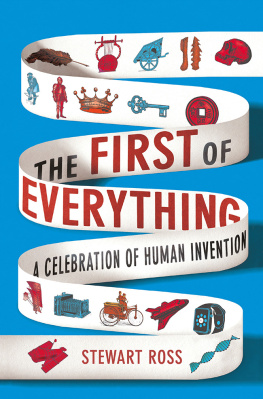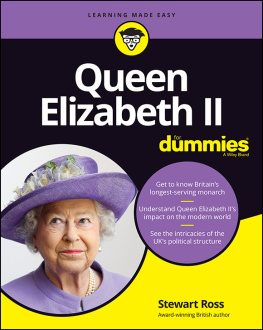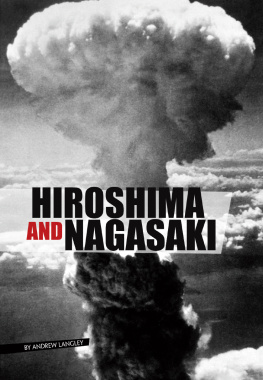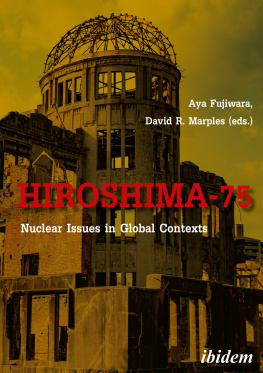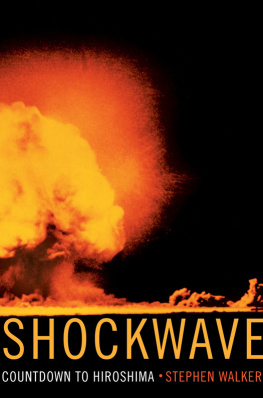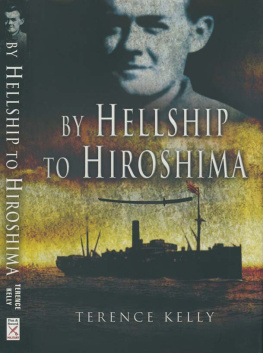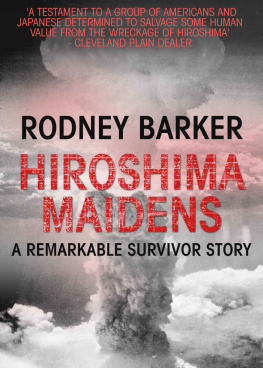Stewart Ross - Hiroshima
Here you can read online Stewart Ross - Hiroshima full text of the book (entire story) in english for free. Download pdf and epub, get meaning, cover and reviews about this ebook. year: 2012, publisher: Encyclopaedia Britannica;Britannica Digital Learning, genre: Politics. Description of the work, (preface) as well as reviews are available. Best literature library LitArk.com created for fans of good reading and offers a wide selection of genres:
Romance novel
Science fiction
Adventure
Detective
Science
History
Home and family
Prose
Art
Politics
Computer
Non-fiction
Religion
Business
Children
Humor
Choose a favorite category and find really read worthwhile books. Enjoy immersion in the world of imagination, feel the emotions of the characters or learn something new for yourself, make an fascinating discovery.

- Book:Hiroshima
- Author:
- Publisher:Encyclopaedia Britannica;Britannica Digital Learning
- Genre:
- Year:2012
- Rating:5 / 5
- Favourites:Add to favourites
- Your mark:
- 100
- 1
- 2
- 3
- 4
- 5
Hiroshima: summary, description and annotation
We offer to read an annotation, description, summary or preface (depends on what the author of the book "Hiroshima" wrote himself). If you haven't found the necessary information about the book — write in the comments, we will try to find it.
Hiroshima tells the story of how the Japanese port city of Hiroshima came to be the target of the worlds first nuclear attack.
Hiroshima — read online for free the complete book (whole text) full work
Below is the text of the book, divided by pages. System saving the place of the last page read, allows you to conveniently read the book "Hiroshima" online for free, without having to search again every time where you left off. Put a bookmark, and you can go to the page where you finished reading at any time.
Font size:
Interval:
Bookmark:

I said, Yeah, were going on a bombing mission, but its a little bit special. My tailgunner, Bob Caron, was pretty alert. He said, Colonel, we wouldnt be playing with atoms today, would we? I said, Bob, youve got it just exactly right. So I went back and told the [others]. I said, OK, this is an atom bomb were dropping I didnt see any change in their faces or anything else.
Colonel Paul Tibbets recalls talking to his crew shortly after takeoff. From an interview with Studs Terkel, 2002.

E-book published in 2012 by Encyclopdia Britannica, Inc., in association with Arcturus Publishing Limited, 26/27 Bickels Yard, 151-153 Bermondsey Street, London SE1 3HA. Britannica, Encyclopdia Britannica, and the Thistle logo are registered trademarks of Encyclopdia Britannica, Inc.
ISBN 978-1-61535-628-7 (e-book)
This edition first published in 2010 by Arcturus Publishing
Distributed by Black Rabbit Books
P.O. Box 3263
Mankato
Minnesota MN 56002
Copyright 2010 Arcturus Publishing Limited
The right of Stewart Ross to be identified as the author of this
work has been asserted by him in accordance with the
Copyright, Designs and Patents Act 1988.
All rights reserved.
Series concept: Alex Woolf
Editors: Sean Connolly and Alex Woolf
Designer: Phipps Design
Picture research: Alex Woolf
Map illustrator: Stefan Chabluk
Library of Congress Cataloging-in-Publication Data
Ross, Stewart.
Hiroshima / Stewart Ross.
p. cm. -- (A place in history)
Includes bibliographical references and index.
1. Hiroshima-shi (Japan)--History--Bombardment, 1945-
Juvenile literature. 2. Atomic bomb--Japan--Hiroshima-shi-
History--Juvenile literature. I. Title.
D767.25.H6R67 2011
940.54'2521954--dc22
2010014149
Picture Credits
Arcturus: 9 (Stefan Chabluk).
Corbis: cover foreground (Bettmann), cover background (John van Hasselt/Sygma), 67 (John van Hasselt/Sygma), 11 (Bettmann), 13 (Hulton-Deutsch Collection), 15 (Bettmann), 16 (Bettmann), 17 (Philip Gendreau), 19 (Bettmann), 20 (Bettmann), 21 (Bettmann), 22 (Bettmann), 23, 24 (Walter Bibikow), 25 (Karen Kasmauski), 26 (Bettmann), 27 (Bettmann), 28 (Louie Psihoyos/Science Faction), 29 (Bettmann), 30 (Bettmann), 31 (Bettmann), 32 (Bettmann), 33
(Hulton-Deutsch Collection), 35 (Bettmann), 36 (Bettmann), 37 (Bettmann), 39 (Jo Yong-Hak/Reuters), 40 (Bettmann), 41 (Shen Hong/XinHua/Xinhua Press), 42 (Sen/Amana Images), 43 (Andy Rain/epa).
Getty Images: 10 (Keystone/Hulton Archive), 12 (Roger Viollet).
Shutterstock: 8 (Sam DCruz).
Cover pictures:
Foreground: A Japanese infant sits crying in the rubble left by the explosion of the atomic bomb at Hiroshima.
Background: The mushroom cloud over Hiroshima.
Every attempt has been made to clear copyright. Should there be any inadvertent omission, please apply to the copyright holder for rectification.
SL001440US Supplier 03 Date 0510
Having found the bomb we have used it. We have used it against those who attacked us without warning against those who have starved and beaten and executed American prisoners of war We have used it in order to shorten the agony of war, in order to save the lives of thousands and thousands of young Americans.
President Truman explains his decision to drop the bomb, August 8, 1945

All clear for takeoff: the Enola Gay, a specially modified B-29 Super Fortress, stands poised on the runway at Tinian before setting out on the most momentous bombing mission in history.
C olonel Paul W. Tibbets Jr. was reckoned the best flier in America. He had even served as personal pilot to General Eisenhower, the future president. So it was no surprise that he was chosen to command one of the most secret missions the United States had ever undertaken.
Shortly after midnight on August 6, 1945, Tibbets and 11 hand-picked crew members clambered aboard the Enola Gay, a modified B-29 Super Fortress based on the Pacific island of Tinian. Tibbets had picked the plane personally, naming it after his mother back in Miami, Florida. Attached to the 509th Composite Group, it featured reduced armor and only one gunner, Sergeant Bob Caron. Bob sat out alone in the tail behind his twin. 50 caliber machine guns. Although he didnt know it at the time, he would play a key role in the operation. His camera would be the only one to take live pictures of the action.
At around 2:45 a.m. the four Wright R3350 engines roared into life and hauled the heavily laden Enola Gay along the runway and into the air. Tibbets immediately headed northwest, toward southern Japan. Officially he alone knew the precise purpose of their mission. Behind him, however, Second Lieutenant Morris Jeppson also had a fair idea.
A physicist who had read a secondhand copy of a banned book on nuclear explosions, Jeppson realized that Little Boy, the 10-ton weapon hanging in the bay beneath them, was not just a super powerful bomb, as they had been told. The Enola Gay was carrying the worlds first atomic bomb. Its target was the city of Hiroshima.
T o most people, the word Hiroshima means only one thing: the terrifying dawn of the nuclear age. The center of the city was totally destroyed by the bomb that the Enola Gay dropped. World War II ended shortly afterward when the Japanese accepted that they faced a weapon against which they had no defense. Untold thousands died in the blast and firestorm that followed, and for years thousands more continued to perish from the effects of radiation. The dark shadow of Hiroshima has hung over the world ever since, a shadow so terrifying that for almost 70 years no nation has dared use nuclear weapons in anger.
FACT FILE
Mori and Asano
The powerful nobleman Mori Terumoto, head of the Mori clan, founded the city of Hiroshima in 1598. He made it his clan headquarters and cemented his power with a new and impressive castle. Later, in the hands of the Asano clan, Hiroshima expanded and prospered. Asano rule ended in the mid-19th century, when the transformation into the modern industrial port began.

Hiroshima Castle, originally built in the 1590s, was obliterated by the nuclear attack of August 6, 1945. The reconstruction shown here was finished 13 years later.

In 1945, Hiroshima was one of the key ports of southern Japan. The city was home to around 43,000 soldiers ready to resist any Allied invasion. Estimates of the civilian population at the time of the Enola Gay raid vary from 255,000 to close on 400,000.
Japan is made up of more than 6,800 islands. Just four of themHonsh, Hokkaid, Kysh, and Shikokucomprise some 97 percent of the countrys land area. The principal island is Honsh, or Main State. The seventh largest island in the world, it is bigger than Great Britain and only slightly smaller than Kansas. Along Honshs crowded southeastern coastline are most of Japans great cities: Tokyo, Kyoto, Osaka, and, at the southern end, Hiroshima.
Next pageFont size:
Interval:
Bookmark:
Similar books «Hiroshima»
Look at similar books to Hiroshima. We have selected literature similar in name and meaning in the hope of providing readers with more options to find new, interesting, not yet read works.
Discussion, reviews of the book Hiroshima and just readers' own opinions. Leave your comments, write what you think about the work, its meaning or the main characters. Specify what exactly you liked and what you didn't like, and why you think so.

